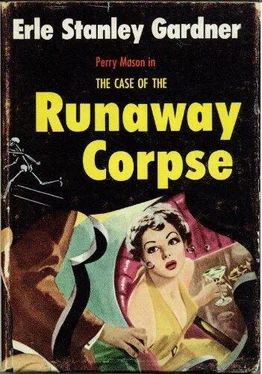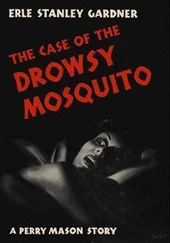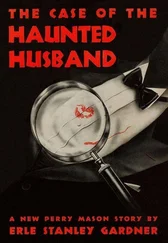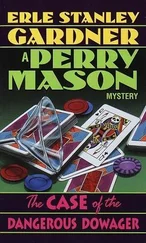Erle Gardner - The Case of the Runaway
Здесь есть возможность читать онлайн «Erle Gardner - The Case of the Runaway» весь текст электронной книги совершенно бесплатно (целиком полную версию без сокращений). В некоторых случаях можно слушать аудио, скачать через торрент в формате fb2 и присутствует краткое содержание. Год выпуска: 0101, Жанр: Классический детектив, на английском языке. Описание произведения, (предисловие) а так же отзывы посетителей доступны на портале библиотеки ЛибКат.
- Название:The Case of the Runaway
- Автор:
- Жанр:
- Год:0101
- ISBN:нет данных
- Рейтинг книги:5 / 5. Голосов: 1
-
Избранное:Добавить в избранное
- Отзывы:
-
Ваша оценка:
- 100
- 1
- 2
- 3
- 4
- 5
The Case of the Runaway: краткое содержание, описание и аннотация
Предлагаем к чтению аннотацию, описание, краткое содержание или предисловие (зависит от того, что написал сам автор книги «The Case of the Runaway»). Если вы не нашли необходимую информацию о книге — напишите в комментариях, мы постараемся отыскать её.
The Case of the Runaway — читать онлайн бесплатно полную книгу (весь текст) целиком
Ниже представлен текст книги, разбитый по страницам. Система сохранения места последней прочитанной страницы, позволяет с удобством читать онлайн бесплатно книгу «The Case of the Runaway», без необходимости каждый раз заново искать на чём Вы остановились. Поставьте закладку, и сможете в любой момент перейти на страницу, на которой закончили чтение.
Интервал:
Закладка:
“Frankly, I would—unless he might have bitten into the candy which could have caused his death, detected a strange flavor, and have spit out the candy, yet swallowed enough of the poisoned liquid in the candy to have caused death. I assume that is what happened. I think from all the facts it is what must have happened, but I can’t find any physical evidence which will enable me to testify it did happen. And I don’t see how he could possibly have ingested the poison I found in his stomach unless he had eaten an entire piece of candy at the very least.”
“Then you don’t actually know how the man ingested the poison which caused his death?”
“No, sir.”
“How long had he been dead?”
“I am unable to determine. I would say somewhere around twenty-four to thirty-six hours.”
“What about a condition known as rigor mortis, Doctor?”
“At the time I made the examination rigor mortis was well marked in the thighs and legs but the neck and shoulders were limp.”
“What about post-mortem lividity?”
“That was well developed, indicating that the position of the body had been unchanged after death, that is, within a short time after death.”
“Now as I understand it, rigor mortis develops first in the face and jaws, then gradually extends downward?”
“That is correct.”
“And it leaves the body in the same way?”
“Yes, sir.”
“How long does it take rigor mortis to develop?”
“It varies. But under ordinary circumstances from eight to twelve hours.”
“Now in this case rigor mortis had not only developed but had enveloped the entire body, then it had begun to disappear. Is that correct?”
“That is substantially true, yes.”
“According to the authorities I believe that the envelopment of the entire body in rigor mortis is supposed to take about eighteen hours?”
“It varies.”
Mason said, “Are you familiar with the writings of Dr. LeMoyne Snyder?”
“Yes, sir.”
“I believe that in his book, Homicide Investigation , Dr. LeMoyne Snyder considers a hypothetical case such as you have described where rigor mortis is still well marked in the thighs and legs, and estimates such a situation as indicating that death took place from twenty-nine to thirty-four hours previously.”
“I am not entirely familiar with his schedule on that.”
“But you would say that that was substantially correct?”
“I would say it could well be, yes.”
“Now you are referring to the condition of the body at the time you performed the post-mortem?”
“That is correct.”
“And you did not perform the post-mortem until some hours after the body had been discovered?”
“That is true.”
“I believe you said your post-mortem was performed about midnight?”
“Yes, sir.”
“And you’re referring to the condition of the body at the time you saw it?”
“Yes, sir.”
“So, generally speaking, the man must have met his death at from two o’clock in the afternoon to seven o’clock in the evening of the preceding day, which was Monday, the twelfth. Is that correct?”
“Well, that is correct if you are going to take such a time chart, but rigor mortis is exceedingly variable. It depends upon temperature. It depends upon certain conditions. I have seen rigor mortis develop almost immediately when death has occurred after a struggle under conditions of temperature which—”
“Were there any evidences of struggle in this case?”
“No, there were not.”
“You wouldn’t care to fix a definite time by the development of rigor mortis?”
“Not definitely.”
“But you do know that such an authority as Dr. LeMoyne Snyder has claimed that under ordinary circumstances the development of rigor mortis such as you observed in the body at this time would have indicated that death had occurred between the hours of two o’clock and seven o’clock of the preceding day?”
“Yes, sir. I guess so.”
“Not what you guess, Doctor, but what you know.”
“Yes, that is true.”
“Had you considered this fact as being a development in the case?”
“Frankly, I had not.”
“Why, Doctor?”
“Because of the fact that a doctor certified the time of death as being between two and three o’clock in the afternoon of the day preceding, and there is nothing in the schedule of rigor mortis which can be narrowed down definitely. Dr. Snyder and other authorities are dealing only with average cases. They can’t lay down rules which can definitely determine the time of death in any individual case. They are talking in terms of generalities, and there is nothing more tricky, or I may say nothing which offers more of a variable under existing conditions, than the development of rigor mortis.”
“You are familiar with the symptoms of arsenic poisoning, Doctor?”
“Yes, sir.”
“And what are those symptoms?”
“Generally there is a burning of the mouth and the throat. There are abdominal cramps with nausea and vomiting. There is usually diarrhea. There are times under certain circumstances when the first symptoms are somewhat delayed, but as a rule the first symptoms are very rapid in their development after the ingestion of the poison.”
“Thank you, Doctor,” Mason said. “I have no further questions.”
Vandling said, “Call Harold Titus to the stand.”
Titus came forward, was sworn, testified that he was a deputy sheriff, that he had specialized in the study of fingerprints, that he had been present at the time when the body of Edward Davenport was discovered in the grave about three miles out of Crampton, that he had taken fingerprints of the dead man, and that he had compared a thumbprint with that on the driving license issued to Edward Davenport and that the prints were identical.
“Had you previously made an investigation in a motor court at Crampton in connection with this case?”
“I had. Yes, sir.”
“What time was that investigation made?”
“About half-past three on the afternoon of the twelfth.”
“That was Monday?”
“Yes, sir.”
“What did you discover?”
“I discovered a locked room in which a corpse was supposed to be located. The door was opened and there was no corpse in the room. There was no one in the room. There was an open window and a loosened screen. There were men’s clothes in the room. There was a handbag, a box of candy. There was a wallet containing various papers of identification indicating that the room had been occupied by one Edward Davenport.”
“Did you meet the defendant, Myrna Davenport, at that time?”
“I did. Yes, sir.”
“And did she make any statements to you with reference to the identity of the man who had occupied that unit?”
“Yes, sir.”
“Who did she say the man was?”
“Edward Davenport, her husband.”
“What did she say about his condition?”
“That he was in a dying condition when she and her companion, a Mrs. Ansel, arrived.”
“Did she say whether she and Mrs. Ansel had been admitted to the room?”
“Yes. She said that they both went into the room, that afterward she had retired, that shortly afterward her husband had taken a turn for the worse, that his respiration was very shallow, that he was barely breathing, that the doctor was called and announced that the man’s condition was very serious. The doctor had been with him when he died. The doctor had then locked up the room after having stated that the circumstances of the death were such that he could not sign a death certificate.”
“Did she make any further statements?”
“There were some statements to the effect that the conduct of the doctor had indicated to her mind that he was insinuating she had murdered her husband and she naturally resented that.”
Читать дальшеИнтервал:
Закладка:
Похожие книги на «The Case of the Runaway»
Представляем Вашему вниманию похожие книги на «The Case of the Runaway» списком для выбора. Мы отобрали схожую по названию и смыслу литературу в надежде предоставить читателям больше вариантов отыскать новые, интересные, ещё непрочитанные произведения.
Обсуждение, отзывы о книге «The Case of the Runaway» и просто собственные мнения читателей. Оставьте ваши комментарии, напишите, что Вы думаете о произведении, его смысле или главных героях. Укажите что конкретно понравилось, а что нет, и почему Вы так считаете.












